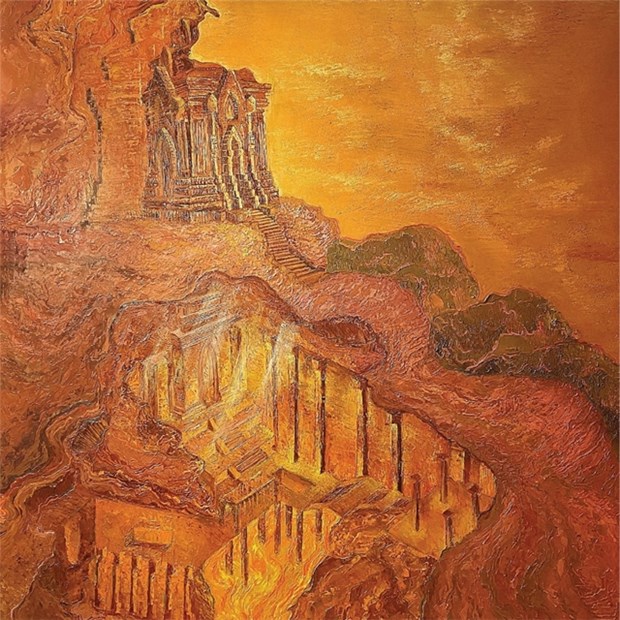Paintings bring ancient Vietnamese architecture to life
Oil paintings featuring unique ancient Vietnamese architecture from across the nation are being exhibited at Van Mieu–Quoc Tu Giam (Temple of Literature Complex).
 A painting of Luu Cu Temple by Nguyen Thanh Vu. The temple today is a relic in Tra Vinh province.
A painting of Luu Cu Temple by Nguyen Thanh Vu. The temple today is a relic in Tra Vinh province.The exhibition, entitled Ky An Viet Nam (Mysterious Vietnam), has been organised by the Vietnam National Institute of Culture and Arts Studies in collaboration with the Van Mieu–Quoc Tu Giam Culture and Science Centre. It is also the first art exhibition to ever be held within the special national relic.
It introduces to the public the first 20 artworks of 27-year-old HCMC-based painter Nguyen Thanh Vu.
The oil paintings of different sizes depict many famous heritages and landscapes from the north to the south of the country, such as Lung Cu Flag Pole, St Joseph's Cathedral, Bao Thien Tower and the Notre Dame Cathedral in HCM City.
Besides familiar architectural works that still exist today, visitors can also see some of Vu’s more unfamiliar painting or ones that have gone into historical documents like the Luu Cu Temple in the southern province of Tra Vinh, that existed during Oc Eo Culture (1st-7th century).
According to the painter, the Vietnamese people have created many unique architectural works with national history, each of which is imbued with time imprints and historical mysteries.
“However, such wonderful stories have neither been known nor thoroughly understood by many. The existence of Ca Lau Citadel or the secrets of Luu Cu relic might not be known and that’s why Mysterious Vietnam was born,” he said.
Sharing with Tien Phong (Vanguard) newspaper, Vu said he had nurtured the idea of creating a collection of artworks that showcase the typical architectural, heritage and geographical features of Vietnam for a long time.
He embarked on the realisation of his idea in June 2021 when the COVID-19 pandemic broke out and finished the final touch on the final painting of this exhibition at the end of this March.
Pursuing Post-Impressionism, Vu wishes to convey a strong vitality, enthusiasm as well as youth and peace through his works.
According to Le Xuan Kieu, director of Van Mieu–Quoc Tu Giam Culture and Science Centre, Mysterious Vietnam is expected to spread the fond interest in the ancestors' legacy among the youth.
“I highly welcome the creativity of young people on the basis of the legacy that the ancestors have worked hard to nourish and pass down on. This exhibition is hoped to inspire the youth with positive energy and creativity so there would be more compositions with diverse perspectives on the nation's heritage would be created in the future,” he noted.
Associate Professor Dr Nguyen Thi Thu Phuong, Director of the Vietnam National Institute of Culture and Arts Studies, assessed that the 20 exhibited works depicting Vietnam’s cultural resources and heritage with the artist’s enthusiasm and creativity also demonstrate Vietnamese cultural identity and a lively Vietnam.
Vu also expressed his hope to continue to set out on more trips to learn more about the heritages and extend Mysterious Vietnam.
The exhibition will conclude on May 30./.













